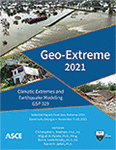The Impact of Hazard-Consistent Ground Motion Scenarios Selection on Structural Seismic Risk Estimation
Publication: Geo-Extreme 2021
ABSTRACT
Structural risk-based evaluation requires a large number of time-history analyses at different ground-motion (GM) intensity levels, where the scenarios (e.g., magnitude and distance) of the GMs used in the time-history analyses should be consistent with the site’s hazard. The current practice of GM selection typically simplifies the choice of scenario to either an average scenario or the modal scenarios based on the site’s hazard deaggregation results. This paper investigates the impact of hazard deaggregation and scenario selection on estimating structural seismic risk. For a hypothetical site in the eastern US, a Monte Carlo seismic hazard analysis is performed to derive a site-consistent GM suite that captures 1,000,000 years of the site’s seismic activity. The complete GM suite consisting of 99,917 records is then used to perform nonlinear dynamic analyses on a midrise concrete office building to derive a benchmark seismic demand curve. Subsequently, four GM sets are selected based on average and modal scenarios from two different hazard deaggregation formulation, and the resulting demand curves are compared to the benchmark. The results show that the hazard deaggregation method and scenario choice impacts the demand curve estimation. When deaggregation is performed on IM exceedance, GMs that were selected based on both methods agree well with the benchmark up to higher damage states where mode-based records outperform average-based records. On the other hand, when deaggregation is formulated based on IM occurrence, average scenario-based GMs better match the benchmark, except for higher damage states where again modal scenario-based GMs are in better agreement with the benchmark.
Get full access to this article
View all available purchase options and get full access to this chapter.
REFERENCES
Bahrampouri, M., Rodriguez-Marek, A., and Green, R. A. (2020). “Ground Motion Prediction Equations for Significant Duration Using the Kik-Net Database.” Earthquake Spectra.
Baker, J. W. (2011). “Conditional Mean Spectrum: Tool for Ground-Motion Selection.” Journal of Structural Engineering.
Baker, J. W. (2015). “Efficient analytical fragility function fitting using dynamic structural analysis.” Earthquake Spectra.
Bayless, J., and Abrahamson, N. A. (2019). “An empirical model for the interfrequency correlation of epsilon for fourier amplitude spectra.” Bulletin of the Seismological Society of America.
Boore, D. M. (2003). “Simulation of ground motion using the stochastic method.” Pure and Applied Geophysics, 160(3–4), 635–676.
Bradley, B. A. (2012). “A ground motion selection algorithm based on the generalized conditional intensity measure approach.” Soil Dynamics and Earthquake Engineering.
Fox, M. J., Stafford, P. J., and Sullivan, T. J. (2016). “Seismic hazard disaggregation in performance‐based earthquake engineering: occurrence or exceedance?” Earthquake Engineering & Structural Dynamics, Wiley Online Library, 45(5), 835–842.
Frankel, A., Mueller, C., Barnhard, T., Perkins, D., Leyendecker, E., Dickman, N., Hanson, S., and Hopper, M. (1996). National seismic hazard maps, June 1996,.
Haselton, C. B., Liel, A. B., and Lange, S. T. (2008). “Beam-Column Element Model Calibrated for Predicting Flexural Response Leading to Global Collapse of RC Frame Buildings.” Peer 2007, 03(May).
Hazus. (2012). Hazus–MH 2.1: Technical Manual. Federal Emergency Management Agency.
Ibarra, L. F., Medina, R. A., and Krawinkler, H. (2005). “Hysteretic models that incorporate strength and stiffness deterioration.” Earthquake Engineering and Structural Dynamics, 34(12), 1489–1511.
Iervolino, I., Chioccarelli, E., and Convertito, V. (2011). “Engineering design earthquakes from multimodal hazard disaggregation.” Soil Dynamics and Earthquake Engineering.
Kohrangi, M., Vamvatsikos, D., and Bazzurro, P. (2020). “Multi-level conditional spectrum-based record selection for IDA.” Earthquake Spectra.
Kwong, N. S., and Chopra, A. K. (2016). “Evaluation of the exact conditional spectrum and generalized conditional intensity measure methods for ground motion selection.” Earthquake Engineering and Structural Dynamics, 45(5), 757–777.
Kwong, N. S., and Chopra, A. K. (2020). “Selecting, scaling, and orienting three components of ground motions for intensity-based assessments at far-field sites.” Earthquake Spectra, SAGE Publications Sage UK: London, England, 8755293019899954.
Lin, T., Harmsen, S. C., Baker, J. W., and Luco, N. (2013a). “Conditional spectrum computation incorporating multiple causal earthquakes and ground-motion prediction models.” Bulletin of the Seismological Society of America.
Lin, T., Haselton, C. B., and Baker, J. W. (2013b). “Conditional spectrum-based ground motion selection. Part I: Hazard consistency for risk-based assessments.” Earthquake Engineering and Structural Dynamics.
McKenna, F. (2011). “OpenSees: A framework for earthquake engineering simulation.” Computing in Science and Engineering.
Musson, R. M. W. (2000). “The use of Monte Carlo simulations for seismic hazard assessment in the U.K.” Annali di Geofisica.
Simon Kwong, N., and Chopra, A. K. (2017). “A Generalized Conditional Mean Spectrum and Its Application for Intensity-Based Assessments of Seismic Demands.” Earthquake Spectra.
Talwani, P., and Chapman, M. C. (2006). Seismic Hazard Mapping for Bridge and Highway Design in South Carolina.
Tarbali, K., and Bradley, B. A. (2015). “Ground motion selection for scenario ruptures using the generalised conditional intensity measure (GCIM) method.” Earthquake Engineering and Structural Dynamics.
Zaker Esteghamati, M., and Huang, Q. (2019). “An efficient stratified-based ground motion selection for cloud analysis. ” 13th International Conference on Applications of Statistics and Probability in Civil Engineering (ICASP13), Seoul, South Korea.
Zaker Esteghamati, M., Lee, J., Musetich, M., and Flint, M. M. (2020). “INSSEPT: An open-source relational database of seismic performance estimation to aid with early design of buildings.” Earthquake Spectra, doi:https://doi.org/10.1177/8755293020919857.
Zareian, F., and Medina, R. A. (2010). “A practical method for proper modeling of structural damping in inelastic plane structural systems.” Computers and Structures, 88(1–2), 45–53.
Information & Authors
Information
Published In
Copyright
© 2021 American Society of Civil Engineers.
History
Published online: Nov 4, 2021
Authors
Metrics & Citations
Metrics
Citations
Download citation
If you have the appropriate software installed, you can download article citation data to the citation manager of your choice. Simply select your manager software from the list below and click Download.
